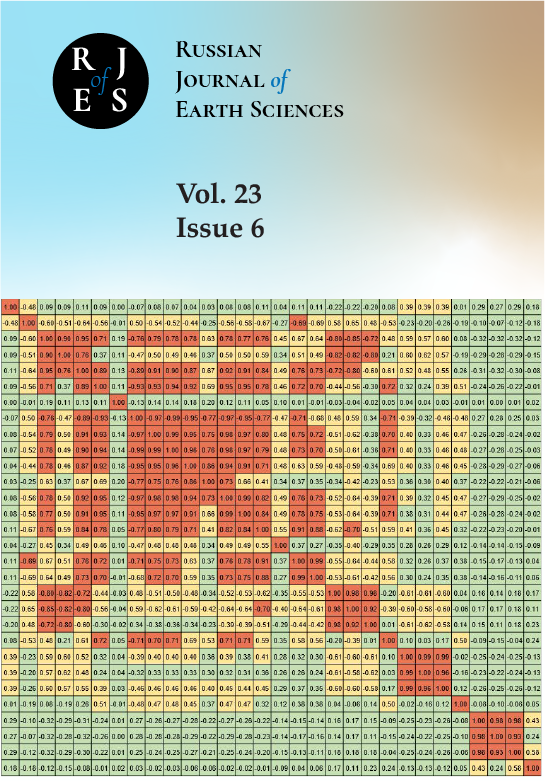from 01.01.2011 until now
Gorno-Altaisk, Gorno-Altaysk, Russian Federation
Gorno-Altaisk, Gorno-Altaysk, Russian Federation
Gorno-Altaisk, Gorno-Altaysk, Russian Federation
UDC 55
UDC 550.34
UDC 550.383
CSCSTI 37.01
CSCSTI 37.15
CSCSTI 37.25
CSCSTI 37.31
CSCSTI 38.01
CSCSTI 36.00
CSCSTI 37.00
CSCSTI 38.00
CSCSTI 39.00
CSCSTI 52.00
Russian Classification of Professions by Education 05.00.00
Russian Library and Bibliographic Classification 26
Russian Trade and Bibliographic Classification 63
BISAC SCI SCIENCE
This paper discusses one of the approaches that allows us to assess the degree of complexity or randomness of fragments of a time series in order to detect infrasound or geomagnetic signals in the results of observations of the dynamics of the natural or man-made processes under study. In our case, we are talking about monitoring the infrasound background on the territory of the Altai Republic. To solve the problem of estimating the required characteristics of a time series with minimal computational costs and in real time, a complex indicator of the stability of permutation entropy is introduced, since estimating the value of classical permutation entropy for n = 3 (the most commonly used version of permutation entropy) does not allow solving the problem with sufficient accuracy.
infrasound monitoring, time series, permutation entropy, complexity assessment, stratospheric waveguide, turning points
1. Chumak, O. V. (2012), Entropies and fractals in data analysis, R&C Dynamics, https://doi.org/10.13140/2.1.4739.6800 (in Russian).
2. Fu, S., Y. Huang, T. Feng, D. Nian, and Z. Fu (2019), Regional contrasting DTR’s predictability over China, Physica A: Statistical Mechanics and its Applications, 521, 282–292, https://doi.org/10.1016/j.physa.2019.01.077.
3. Higuchi, T. (1988), Approach to an irregular time series on the basis of the fractal theory, Physica D: Nonlinear Phenomena, 31(2), 277–283, https://doi.org/10.1016/0167-2789(88)90081-4.
4. Kandal, M. (1981), Time series, Finance and Statistics, Moscow (in Russian).
5. Liang, T., G. Xie, D. Mi, W. Jiang, and G. Xu (2020), PM2.5 Concentration Forecasting Based on Data Preprocessing Strategy and LSTM Neural Network, International Journal of Machine Learning and Computing, 10(6), 729–734, https://doi.org/10.18178/ijmlc.2020.10.6.997
6. Lu, P., L. Ye, M. Pei, Y. Zhao, B. Dai, and Z. Li (2022), Short-term wind power forecasting based on meteorological feature extraction and optimization strategy, Renewable Energy, 184, 642–661, https://doi.org/10.1016/j.renene.2021.11.072.
7. Microsin.net (2020), INMP441: digital microphone with interface I2S, https://microsin.net/adminstuff/hardware/inmp4 41-i2s-omnidirectional-digital-microphone.html (in Russian), (visited on 18.02.2024).
8. Roushangar, K., R. Ghasempour, V. S. O. Kirca, and M. C. Demirel (2021), Hybrid point and interval prediction approaches for drought modeling using ground-based and remote sensing data, Hydrology Research, 52(6), 1469–1489, https://doi.org/10.2166/nh.2021.028.
9. Schwardt, M., C. Pilger, P. Gaebler, P. Hupe, and L. Ceranna (2022), Natural and Anthropogenic Sources of Seismic, Hydroacoustic, and Infrasonic Waves: Waveforms and Spectral Characteristics (and Their Applicability for Sensor Calibration), Surveys in Geophysics, 43(5), 1265–1361, https://doi.org/10.1007/s10712-022-09713-4.
10. Sidorov, R., A. Soloviev, R. Krasnoperov, D. Kudin, A. Grudnev, Y. Kopytenko, A. Kotikov, and P. Sergushin (2017), Saint Petersburg magnetic observatory: from Voeikovo subdivision to INTERMAGNET certification, Geoscientific Instrumentation, Methods and Data Systems, 6(2), 473–485, https://doi.org/10.5194/gi-6-473-2017.
11. Silva, A. S. A., R. S. C. Menezes, O. A. Rosso, B. Stosic, and T. Stosic (2021), Complexity entropy-analysis of monthly rainfall time series in northeastern Brazil, Chaos, Solitons & Fractals, 143, https://doi.org/10.1016/j.chaos.2020.110623.
12. Soloviev, A., V. Lesur, and D. Kudin (2018), On the feasibility of routine baseline improvement in processing of geomagnetic observatory data, Earth, Planets and Space, 70(1), https://doi.org/10.1186/s40623-018-0786-8.
13. St-Louis, B. (Ed.) (2020), INTERMAGNET Technical Reference Manual, Version 5.0.0, INTERMAGNET Operations Committee and Executive Council, https://doi.org/10.48440/INTERMAGNET.2020.001.
14. Traversaro, F., F. O. Redelico, M. R. Risk, A. C. Frery, and O. A. Rosso (2018), Bandt-Pompe symbolization dynamics for time series with tied values: A data-driven approach, Chaos: An Interdisciplinary Journal of Nonlinear Science, 28(7), https://doi.org/10.1063/1.5022021.
15. Zhang, T., C. Cheng, and P. Gao (2019), Permutation Entropy-Based Analysis of Temperature Complexity Spatial-Temporal Variation and Its Driving Factors in China, Entropy, 21(10), 1001, https://doi.org/10.3390/e21101001.
16. Zhu, G., J. Hunter, and Y. Jiang (2016), Improved Prediction of Dengue Outbreak Using the Delay Permutation Entropy, in 2016 IEEE International Conference on Internet of Things (iThings) and IEEE Green Computing and Communications (GreenCom) and IEEE Cyber, Physical and Social Computing (CPSCom) and IEEE Smart Data (SmartData), IEEE, https://doi.org/10.1109/iThings-GreenCom-CPSCom-SmartData.2016.172.
17. Zunino, L., M. C. Soriano, and O. A. Rosso (2012), Distinguishing chaotic and stochastic dynamics from time series by using a multiscale symbolic approach, Physical Review E, 86(4), https://doi.org/10.1103/PhysRevE.86.046210.















